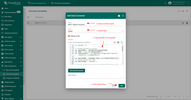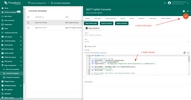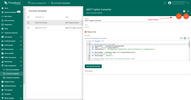- Overview
- Create Converter templates
- Create Integration template
- Modify Edge Root Rule chain for Downlinks
- Assign Integration to Edge
- Send uplink message
- Send One-Way RPC to Device
- Next steps
Overview
MQTT Integration allows to connect to external MQTT brokers, subscribe to data streams from those brokers and convert any type of payload from your devices to ThingsBoard Edge message format. Its typical use is whenever your devices are already connected to external MQTT broker or any other IoT platform or connectivity provider with MQTT based back-end.
Please review the integration diagram to learn more.
ThingsBoard Edge MQTT Integration acts as an MQTT client. It subscribes to topics and converts the data into telemetry and attribute updates. In case of downlink message, MQTT integration converts it to the device-suitable format and pushes to external MQTT broker.
Pay attention: MQTT broker should be either co-located with ThingsBoard Edge instance or deployed in the cloud and have a valid DNS name or static IP address.
Prerequisites
In this tutorial, we will use:
- MQTT broker, accessible by ThingsBoard Edge instance — broker.hivemq.com (port 1883);
- mosquitto_pub and mosquitto_sub MQTT clients to send and receive messages.
Let’s assume that we have a sensor which is sending current temperature readings. Our sensor device SN-001 publishes it’s temperature readings to tb-edge/mqtt-integration-tutorial/sensors/SN-001/temperature, and it is subscribed to tb-edge/mqtt-integration-tutorial/sensors/SN-001/rx to receive RPC calls.
We will send a message with temperature readings in a simple format: {"value":25.1}
Create Converter templates
Converter and Integration templates are created on the Cloud, so please log in as Tenant administrator to cloud instance.
Uplink Converter template
Before creating the Integration template, you need to create an Uplink and Downlink converter templates in Converters templates page.
Uplink Converter is a script for parsing and transforming the data received by MQTT integration. Downlink Converter parses and transforms the data sent from ThingsBoard to the format that is consumed by existing device(s).
Uplink is necessary in order to convert the incoming data from the device into the required format for displaying them in ThingsBoard Edge. Click on the “plus” and on “Create new converter”. To view the events, enable Debug. In the function decoder field, specify a script to parse and transform data.
Example for the Uplink converter:
1
2
3
4
5
6
7
8
9
10
11
12
13
14
15
16
17
18
19
20
21
22
23
24
25
26
27
28
29
30
31
32
33
34
35
36
37
38
/** Decoder **/
// decode payload to string
var payloadStr = decodeToString(payload);
var data = JSON.parse(payloadStr);
var topicPattern = 'tb-edge/mqtt-integration-tutorial/sensors/(.+)/temperature';
var deviceName = metadata.topic.match(topicPattern)[1];
// decode payload to JSON
// Result object with device attributes/telemetry data
var result = {
deviceName: deviceName,
deviceType: 'default',
attributes: {
integrationName: metadata['integrationName'],
},
telemetry: {
temperature: data.value,
}
};
/** Helper functions **/
function decodeToString(payload) {
return String.fromCharCode.apply(String, payload);
}
function decodeToJson(payload) {
// convert payload to string.
var str = decodeToString(payload);
// parse string to JSON
var data = JSON.parse(str);
return data;
}
return result;
The purpose of the decoder function is to parse the incoming data and metadata to a format that ThingsBoard Edge can consume. deviceName and deviceType are required, while attributes and telemetry are optional. Attributes and telemetry are flat key-value objects. Nested objects are not supported.
You can change the decoder function while creating the converter or after creating it. If the converter has already been created, then click on the ‘pencil’ icon to edit it. Copy the configuration example for the converter (or your own configuration) and insert it into the decoder function. Save changes by clicking on the ‘checkmark’ icon.
Downlink Converter template
Create Downlink in Converter templates page as well. To see events select Debug checkbox.
You can customize a downlink according to your configuration. Let’s consider an example where we send an attribute update message. An example of downlink converter:
1
2
3
4
5
6
7
8
9
10
11
12
13
14
15
16
17
18
19
/** Encoder **/
// Result object with encoded downlink payload
var result = {
// downlink data content type: JSON, TEXT or BINARY (base64 format)
contentType: "JSON",
// downlink data
data: JSON.stringify(msg),
// Optional metadata object presented in key/value format
metadata: {
topic: 'tb-edge/mqtt-integration-tutorial/sensors/'+metadata['originatorName']+'/rx'
}
};
return result;
Create Integration template
Now that the Uplink and Downlink converter templates have been created, it is possible to create an integration. Go to Integration templates section and click Add new integration button. Name it Edge MQTT, select type MQTT, turn the Debug mode on and from drop-down menus add recently created Uplink and Downlink converters.
Specify host: ${{brokerIp}}. Port: 1883. It is better to uncheck the Clean session parameter. Many brokers do not support sticky sessions, so will silently close the connection if you try to connect with this option enabled.
Add a Topic Filter tb-edge/mqtt-integration-tutorial/sensors/+/temperature. You can also select an MQTT QoS level. We use MQTT QoS level 0 (At most once) by default.
Let’s leave the Downlink topic pattern by default, meaning that the Integration will take the metadata.topic and use it as the downlink topic.
Click Add to save the Integration.
Modify Edge Root Rule chain for Downlinks
We can send a downlink message to the device from Rule chain using the rule node. To be able to send downlink over integration we need to modify ‘Edge Root Rule chain’ on the cloud. We’ll need to add two rule nodes - originator fields and integration downlink nodes. Set ‘Attributes updated’ link to originator fields and configure to add originator name and type to the message metadata - in the downlink converter name of the device will be used to set proper downlink MQTT topic. And then add Success link from originator fields node to integration downlink node. When changes are made to device attribute on the Edge, the downlink message will be sent to the integration template.
Assign Integration to Edge
Once converter and integration templates are created, we can assign Integration template to Edge. Because we are using placeholder ${{brokerIp}} in the integration configuration, we need to add attribute brokerIp to edge first. You need to provide IP address of the MQTT broker. We are using public URL broker.hivemq.com in this tutorial, but this could be any internal IP address as well. Once attribute added, we are ready to assign integration and verify that it’s added.
- Add brokerIp attribute to Edge and set value as your Edge broker.hivemq.com
- Click Manage Integrations button of Edge entity
- Assign Integration to the Edge
- Login to your ThingsBoard PE Edge instance and open Integrations page - placeholder is going to be replaced by attribute value
Send uplink message
Now let’s simulate the device sending a temperature reading to the integration:
1
mosquitto_pub -h broker.hivemq.com -p 1883 -t "tb-edge/mqtt-integration-tutorial/sensors/SN-001/temperature" -m '{"value":25.2}'
The created device with data can be seen in the section Device groups -> All on the Edge:
Received data can be viewed in the Uplink converter. In the ‘In’ and ‘Out’ blocks of the Events tab:
Send One-Way RPC to Device
Now let’s check downlink functionality. Open the terminal window and execute the following command:
1
mosquitto_sub -h broker.hivemq.com -p 1883 -t "tb-edge/mqtt-integration-tutorial/sensors/+/rx"
Please leave this terminal running in background - in this terminal window you should receive incoming messages sent later by integration.
Let’s add firmware shared attribute:
To make sure that downlink message sent to integration you can check ‘Events’ tab of integration:
An example of incoming messages from ThingsBoard Edge in the terminal:
Next steps
-
Getting started guide - Provide quick overview of main ThingsBoard Edge features. Designed to be completed in 15-30 minutes:
-
Installation guides - Learn how to setup ThingsBoard Edge on various available operating systems and connect to ThingsBoard CE server.
-
Edge Rule Engine:
-
Overview - Learn about ThingsBoard Edge Rule Engine.
-
Rule Chain Templates - Learn how to use ThingsBoard Edge Rule Chain Templates.
-
Provision Rule Chains from cloud to edge - Learn how to provision edge rule chains from cloud to edge.
-
Push data from edge to cloud and vice versa - Learn how to push data from edge to cloud and vice versa.
-
- Security:
- gRPC over SSL/TLS - Learn how to configure gRPC over SSL/TLS for communication between edge and cloud.
-
Features:
-
Edge Status - Learn about Edge Status page on ThingsBoard Edge.
-
Cloud Events - Learn about Cloud Events page on ThingsBoard Edge.
-
-
Use cases:
-
Manage alarms and RPC requests on edge devices - This guide will show how to generate local alarms on the edge and send RPC requests to devices connected to edge:
-
Data filtering and traffic reduce - This guide will show how to send to cloud from edge only filterd amount of device data:
-
- Roadmap - ThingsBoard Edge roadmap.
























